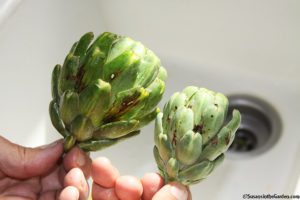Stink Bugs, Brown Marmorated and Green
Latin name: Halyomorpha halys (Brown Marmorated stink bug), Chinavia hilaris (Green stink bug – pictured to right)
Size: 1/2″ long
Color(s): Brown with alternating dark and light bands on their abdomen, antennae and legs.
Introduction: Brown Marmorated Stink Bugs (BMSB) are an exotic insect pest from Asia. They are causing great alarm in the agricultural industry. These insects are extremely damaging to both vegetable and fruit crops. The BMSB was first seen in PA in the 1990s. Sightings of it in the Pacific Northwest began around 2010. They have a shield-shaped body. There are other species in this region, typically with green coloration. They damage some of my vegetable crops each year (refer to photos), but the BMSB is particularly worrisome. They get their name from the fact that they emit a highly-unpleasant odor.
Life cycle: After overwintering, adult females emerge in early spring to lay clusters of eggs on the undersides of leaves. The nymphs hatch in early June and go through 5 instar stages prior to maturing in August.
Signs of their activity: Yellow spots on nearly-ripe tomatoes, holes and frass on artichokes (see photo). Fruits are deformed, some crops have blemishes which affects their marketability.
Typically seen on: Tomatoes, berries, grapes, artichokes, corn, along with some ornamentals.
Controls: Hand-picking; stink bug traps. Consider planting “trap crops” such as sunflowers or legumes near your susceptible plants. That can keep them away.
Natural predators: Chickens, praying mantis, and a tiny wasp (Trissolcus japonicus) that parasitizes the eggs.
Additional information: Washington State University Pest Watch: Brown Marmorated Stink Bug, Oregon State University Brown Marmorated Stink Bug, and Washington University State Extension Brown Marmorated Stink Bug.
Back to Organic Pest Control


